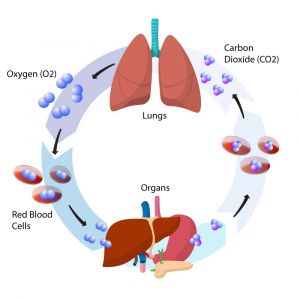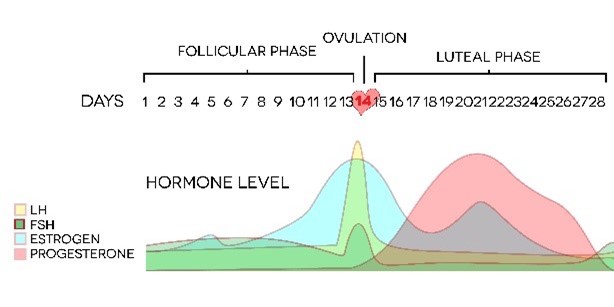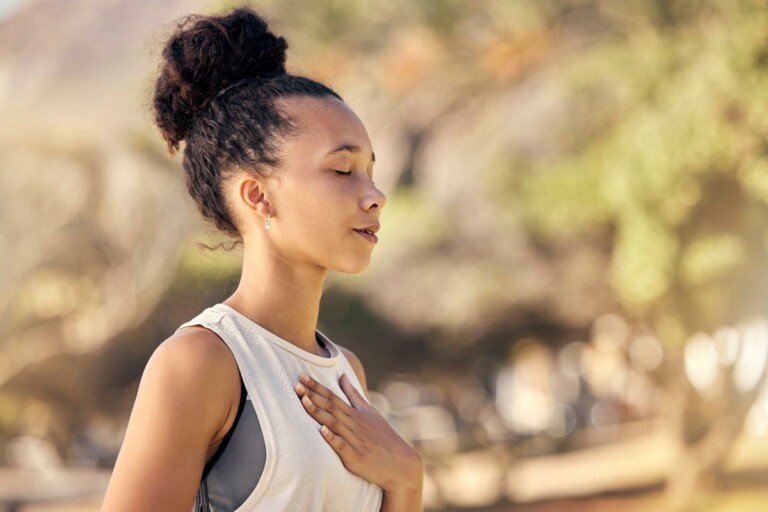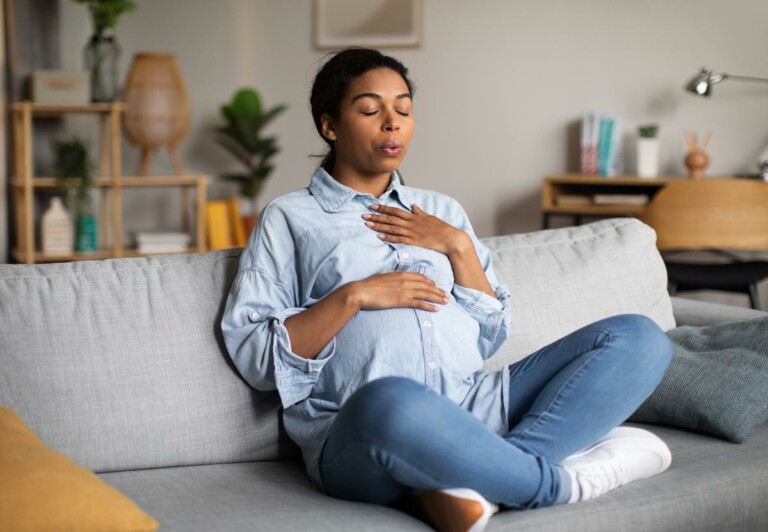Investigating the Interplay between Women’s Physiology and Breathing Patterns
Background scoop on breathing
Breathing is a fundamental process that allows oxygen to reach our organs and tissues. However, many people suffer from dysfunctional breathing patterns, leading to inefficient oxygen utilization. It’s estimated that a staggering 80% of people are likely to have a breathing dysfunction (Keisel 2020)! This article explores the impact of the most common breathing dysfunction, hyperventilation (AKA over breathing) on oxygenation and reviews specific considerations for women. Unfortunately, most medical research conducted has historically been done with male participants that do not have the same hormonal cycles as women. Because of this, the male experience is considered the default, but that is not the case for 50% of the population and thus leads to a gender bias. We will explore how breathing can change throughout the menstrual cycle, with hormonal contraceptives, with pregnancy, and with menopause.
How breathing works

When you inhale, oxygen goes into the lungs and into the small air sacs called alveoli. There are small blood vessels, called capillaries, that wrap around the alveoli to gather oxygen. Once oxygen hits our blood stream, hemoglobin in our red blood cells picks it up and travels around to all our organs, muscles, brain, etc. for delivery. The hemoglobin will then release oxygen in exchange for carbon dioxide (CO2). If you don’t have enough CO2, oxygen won’t be released to the tissues. Hyperventilation or over breathing is common in both women and men.
Hyperventilation leads to CO2 being released from the body too quickly, so we don’t have enough to “pay the piper” for the oxygen. However, in addition to hyperventilation, there are many other reasons that can cause decreased CO2 in the body which primarily affect women.
What changes during the menstrual cycle?
Women experience unique considerations related to breathing, primarily due to the menstrual cycle and hormonal fluctuations. Understanding these influences can shed light on the challenges women may face in maintaining optimal respiratory function at certain times. Let’s explore the different phases of the menstrual cycle and their impact on breathing:

- Menstruation: The “period” where the lining of the uterus is shed and excreted as water and blood. Estrogen and progesterone are low during this time.
- Follicular Phase: Between the first day of your period and ovulation. Estrogen rises to prepare for the release of an egg.
- Proliferative Phase: Uterine lining building up.
- Ovulation: An egg is released. Estrogen peaks and then drops quickly.
- Luteal Phase: Between ovulation and starting menstruation. The body is preparing for a potential pregnancy, so progesterone is produced, peaks, and then quickly drops. This phase is commonly linked to hyperventilation due to the variable progesterone levels. CO2 can drop by more than 25% during this phase.
- Secretory Phase: Uterine lining is prepped for pregnancy or to be shed for menstruation.
It’s the luteal phase that causes the biggest changes in breathing with CO2 dropping by 25% on average. With CO2 dropping, women may not have enough CO2 to trade for oxygen which will cause symptoms of oxygen depletion.
What symptoms of oxygen depletion may look like (Chaitow 2014)
- Respiratory
- Feeling of “air hunger” or not getting enough air
- Low tolerance to exercise (especially more vigorous such as running, stairs)
- Dry cough
- Frequent sighing/yawning
- Musculoskeletal
- Pain and fatigue
- Increased muscle tone (tenderness/spasms/cramping)
- Neurological
- Dizziness
- Headaches
- Fainting
- Tingling
- Cardiac
- Chest pain
- Arrhythmias
- Difficult to control blood pressure
- Mental
- Impaired thinking
- Anxiety/panic
What about contraception?

It makes logical sense that using hormonal contraceptives such as the pill would affect breathing as well. However, the little research there is on this topic is very inconsistent with their findings. Some research shows that there was a decrease in asthma risk in women who took oral contraceptives and other studies that show the exact opposite. This may be due to what women are taking the pill for. Many take it to prevent pregnancy, but others take it to manage medical conditions like polycystic ovary syndrome (PCOS).
PCOS has a known link to asthma and lower lung function. If people with PCOS were included in some studies but not others, it may have swayed the results. A 2012 review stated it was “likely and biologically plausible” that oral contraceptives can affect the airway in many ways (Macsali 2012). Oral contraceptives are an excellent way to manage several different health conditions but can have side effects like any other medication.
And during pregnancy?
Pregnancy understandably affects breathing due to several factors including body changes and hormones. As the fetus grows and the uterus expands, the rest of the organs are pushed up against the diaphragm making it difficult to breathe into the belly and back resulting in shallower chest breathing. Other changes include a 15% increase in metabolic rate and a 20% increased demand for oxygen (McKeown 2021). In terms of hormones, progesterone increased 100-fold during pregnancy and acts as a respiratory stimulant which generally leads to hyperventilation (McKeown 2021).

Now for menopause.

In general, women will go through perimenopause for approximately five years (late 40s) before going into true menopause in their early 50s. Progesterone and estrogen levels drop significantly which generally increases CO2 in the body (remember, this is a good thing!).
However, recent research has shown that going through natural menopause early is associated with reduced lung function (Campbell 2020).
This highlights the relationship between breathing and hormonal changes. It’s not fully understood why this is the case, but the most notable factor was a history of smoking or being exposed to second-hand smoke.
What else impacts our breathing?
Besides hormonal changes, other factors contribute to breathing differences between the sexes. Women tend to have smaller airways, rib cages, and shorter diaphragms compared to men. Resting CO2 levels are on average 8% lower in women than men (McKeown 2021). Additionally, poor diaphragm function, often linked to chronic pelvic pain and dysfunction, can lead to an upper chest breathing pattern, further exacerbating respiratory challenges for women.
The good news!
Fortunately, research demonstrates that breath work can significantly improve dysfunctional breathing patterns. Engaging in guided breathing exercises can lead to clinically significant changes in respiratory function. The guidance of a trained professional is crucial to ensure correct execution and maximize the benefits of breath work.
Optimizing breathing patterns is essential for efficient oxygenation and overall well-being. Dysfunctional breathing, characterized by hyperventilation, disrupts the delicate balance between oxygen and CO2 levels. Women face unique considerations related to the menstrual cycle and hormonal influences on breathing. By incorporating breath work techniques, women can address dysfunctional breathing patterns and enhance their respiratory health. Empowered with this knowledge, individuals can take proactive steps toward optimal oxygen utilization and improved overall health.

Start your physical therapy journey today!
Physical therapists can help you to identify areas that are negatively affecting your breathing and create a customized plan of care to improve your breathing patterns and optimize your health and wellness.
References:
- Campbell, Brittany, Dinh S. Bui, Julie A. Simpson, Caroline J. Lodge, Adrian J. Lowe, Gayan Bowatte, Bénédicte Leynaert et al. “Early Age at Natural Menopause Is Related to Lower Post-Bronchodilator Lung Function. Longitudinal Population-based Study.” Annals of the American Thoracic Society 17, no. 4 (2020): 429-437.
- Chaitow, L., How Breath Can Impact Fibromyalgia Pain. 2017: Associated Bodywork & Massage Professionals.
- Chaitow, L., Chapter 3: Patterns of Breathing Dysfunction in Hyperventilation and Breahting Pattern Disorders. In: Recognizing and Treating Breathing Disorders. 2nd ed. Churchill/Livingstone; 2014: 51-59.
- Gargaglioni, L.H., D.A. Marques, and L.G.A. Patrone, Sex differences in breathing. Comp Biochem Physiol A Mol Integr Physiol, 2019. 238: p. 110543.
- Haugstad, G.K., et al., Continuing improvement of chronic pelvic pain in women after short-term Mensendieck somatocognitive therapy: results of a 1-year follow-up study. Am J Obstet Gynecol, 2008. 199(6): p. 615.e1-8.
- Jenkins, Mark A., Shyamali C. Dharmage, L. B. Flander, Jo A. Douglass, A. M. Ugoni, John B. Carlin, S. M. Sawyer, Graham G. Giles, and John L. Hopper. “Parity and decreased use of oral contraceptives as predictors of asthma in young women.” Clinical & Experimental Allergy 36, no. 5 (2006): 609-613
- Macsali, Ferenc, Cecilie Svanes, Line Bjørge, Ernst R. Omenaas, Francisco Gómez Real, Hutchinson, Mathers et al. “Respiratory health in women: from menarche to menopause.” Expert review of respiratory medicine 6, no. 2 (2012): 187-202.
- Macsali, F., et al., Early age at menarche, lung function, and adult asthma. Am J Respir Crit Care Med, 2011. 183(1): p. 8-14.
- Macsali, F., et al., Respiratory health in women: from menarche to menopause. Expert Rev Respir Med, 2012. 6(2): p. 187-200; quiz 201-2.
- Macsali, F., et al., Menstrual cycle and respiratory symptoms in a general Nordic-Baltic population. Am J Respir Crit Care Med, 2013. 187(4): p. 366-73.
- McKeown, P. Chapter 12: Yes, Breathing is Different for Women. In: The Breathing Cure. 1st ed. Humanix; 2021: 323-344.
- Nillni, Y.I., et al., Sex differences in panic-relevant responding to a 10% carbon dioxide-enriched air biological challenge. J Anxiety Disord, 2012. 26(1): p. 165-72.
- Nillni, Y.I., K.J. Rohan, and M.J. Zvolensky, The role of menstrual cycle phase and anxiety sensitivity in catastrophic misinterpretation of physical symptoms during a CO(2) challenge. Arch Womens Ment Health, 2012. 15(6): p. 413-22.
